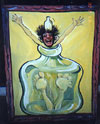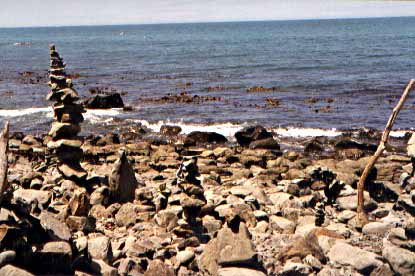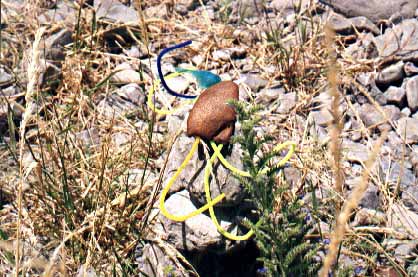| Office
of Moribund Collections
Report
#1 Outdoor Sculpture Park near Kaikoura, Aotearoa/New Zealand "There is nothing beautiful in nature." Camille Paglia
The untitled sculpture "park" is an interesting twist on the concept of public art because here, anonymous members of the untrained public create the art. The standard of creative activity in this area and the fact that one views the work as if one was in a gallery, however, qualifies the park as a moribund collection. And a more moribund collection would be difficult to find. Suffice it to say that all definitions in respect of what is art and what constitutes a gallery are seriously undermined and hence the plethora of inverted commas in this report. This is the ultimate democratic public art space. Environmental artworks are continually created by passers by in an expanse of rocks fronting a particularly rough patch of ocean. Although it is sometimes difficult to distinguish between art and nature, it is clear that many of the art works are such that they could not have been created by natural forces alone. Here a pile of rocks or a swastika imitate high art while flirting courageously with the infinite and the immeasurable. Like Caspar David Friedrich these "artists" have discovered "tragedy in the landscape". I must draw the readers attention to two exemplarary works, where artists have eschewed the notion of placing one rock on top of another and calling it art. The graffiti like swastika painted prominently on a rock is the work of slothful neo Nazis, no doubt on their way to or from Christchurch where they had achieved considerable notoriety for setting a popular sea lion on fire near the New Brighton Pier. (The legendary sea lion has since reeked revenge by terrorising the town of Gisborne) This particular work seems to represent the lack of imagination one finds among members of a group whose creativity is largely directed to acts of cruelty and methods of execution. The question that arises of course is, is it art or politics, or is it either ? The viewer, naturally, must decide for themselves. Notice the passing Kingswood with surfboard, an oblique reference to the classic cult movie "Surf Nazis must die". A more interesting work perhaps is "Untitled seaweed" where we see a piece of seaweed decorated with pipe cleaners and a bright blue feather. Although this piece would probably not last beyond the first high tide it is a satisfying work that attempts and fails the natural and the manufactured. This is indicative of just how vexatious the issue of reconciliation can be. The dyed blue feather is an evocation of "man’s struggle against nature" and celebrates an ability to interfere or tamper with nature at will. This is/was a challenging work indeed that calls to question the difficult definitions of Classical and Romantic landscape while providing a counterpoint to Rousseau’s view that "sentiment counts for more than reason".
|
|



